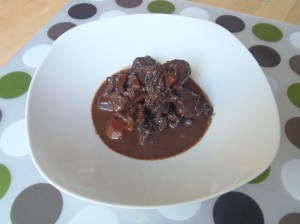 This week I had the opportunity to cook with pig’s blood. There’s actually more classical applications for blood than you may think.
This week I had the opportunity to cook with pig’s blood. There’s actually more classical applications for blood than you may think.
Fresh blood has a beautiful colour, similar to red wine, but with an opalescent sheen. When heated, the blood turns burgundy, then brown, and eventually black. It coagulates somewhere around 75°C, which makes it ideal for thickening liquids.
Civet: A Gateway Dish
If you’re at all squeamish about cooking with blood, this is probably a good dish to start with.
The two things that make a civet a civet are: one, that game is marinated in wine which is later used to braise the meat; and two, that the braising liquid is thickened with blood and used as a sauce. In some cases this is the blood of the animal you are cooking. Collecting the blood of true game animals is difficult because of how they’re killed, so pig’s blood often stands in as a substitute.
In this case I had some stewing meat from a calf elk that Kevin hunted. Here’s the basic procedure.
- Marinate the meat in red wine (I used a Syrah) with sliced onions, carrots, garlic, bay, and black pepper.
- Remove the meat and let it drip dry in a colander.
- Cook bacon in a braising pot. Remove and reserve.
- Brown the game meat in the bacon fat.
- Return the bacon to the pot. Pour the marinating liquid (with sliced vegetables and aromatics) over the meat. Scrap the bottom of the pot with a wooden spoon to capture the delicious fond.
- Cover and simmer until meat is tender, maybe two hours. I also added some reconstituted dried morels partway through the braising.
- Separate the liquid from the meat and vegetables. Remove the bay leaf. Reduce the liquid to concentrate the flavours.
- Pour the sauce over the meat and vegetables.
The purplish brown of the finished dish is from the wine, though the cooked blood happens to have a similar colour.
The blood adds a very pleasing mineral note that works well with the flavour of the meat. It’s also a dead-simple thickener to use. Even quicker than cornstarch or roux, as it doesn’t need to be cooked out. It brought my braising liquid to a nappé consistency in a few moments.
I don’t think I’ve used the word “nappé” on this blog before. Let me explain. “Nappé” (said “nap-EH”) is one of the those fantastic French cooking words that doesn’t have an acceptable substitute in English. Napper (also pronounced “nap-EH”) is the infinitive form of a verb meaning to coat evenly with a thin layer of sauce. When thickening a sauce, the most common way to judge consistency is to simply dip a spoon in the pot, remove, and observe how the sauce clings to the back. In the early liquid stages the sauce will simply slide away, perhaps leaving a few streaks behind. Once the sauce has thickened, it will cleave to the spoon and leave a perfectly even coating. This is a nappé. You should be able to run your finger across this coating and leave a clearly defined streak.